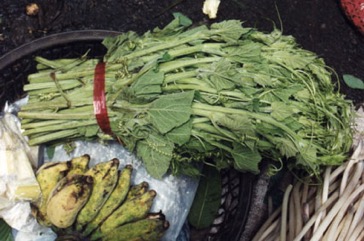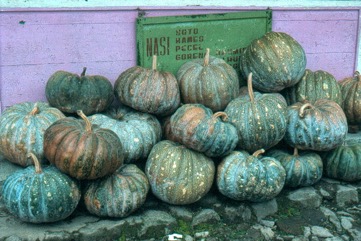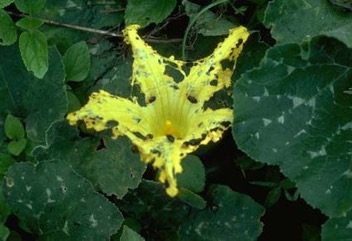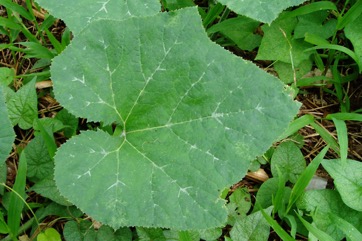Pumpkin, Winter squash

A subtropical plant. They are grown throughout the tropical countries from sea level to 2400 m altitude. They need a fertile soil. C. moschata is better suited to coastal areas. They are frost sensitive but better suited to cooler areas than C. moschata. It can grow in arid places. It suits hardiness zones 8-11.
Also known as:
Amugita, Anamboatavo, Asusa, Baby, Bi do, Bi-ro, Buziriziri, Calabaza, Dzungu, Ebishusha, Elegede,Emyongo, Enjubi, Ensujju, Essujjo, Essunsa, Faan kwa, Gummadi, Kasogo, Imunyuru, Iyongu, Jungu, Kabeewaa, Kabewa, Kaddhu, Kaddu, Kadee, Kadimah, Kalamasa, Kedi, Kicwika, Kimisebebe, Kohara, Kohora, Konokono, Kosekelenge, Kumbalakai, Kumra, Kungull Lal bhopli, Lal dudiya, Lal kumra, Laptanda, Lenge, Lu-cha, Maai, Mai, Ma-part, Mathan, Mistikumra shak, Mitha, Msuku, Muengeleka, Mungu, Muteta, Nadio, Ndiabe, Obututu, Okondo, Parangikayi, Pharsi ko munto, Poosani kolunthu, Shwe-payon, Sitaphal, Tange, Tanje, Tap payo, Te bangketi, Timbin, Tipeti, Ukoko, Wavukeni, Zapallo
Synonyms
- Cucurbita maxima var. turbaniformis (M. Roem.) L. H. Bailey
- Cucurbita turbaniformis M. Roem.
Edible Portion
- Fruit, Leaves, Seeds, Flowers, Vegetable
Where does Pumpkin grow?
Found in: Africa, Albania, Andes, Angola, Argentina, Asia, Australia, Austria, Azerbaijan, Bangladesh, Barbados, Benin, Bolivia, Bougainville, Burkina Faso, Burundi, Cambodia, Cameroon, Caucasus, Central Africa, Central African Republic, CAR, Central America, Central Asia, Chad, China, Colombia, Comoros, Congo DR, Congo R, Cook Islands, Costa Rica, Côte d'Ivoire, Cuba, Dominican Republic, East Africa, East Timor, Eritrea, Ethiopia, Fiji, Gabon, Gambia, Ghana, Guyana, Haiti, Hawaii, Himalayas, India, Indochina, Ivory Coast, Jamaica, Kazakhstan, Kenya, Korea, Laos, Liberia, Macedonia, Madagascar, Malawi, Mali, Mariana Islands, Marquesas, Mauritania, Mauritius, Mediterranean, Mexico, Mozambique, Myanmar, Namibia, Nauru, Nepal, New Caledonia, Niger, Nigeria, North America, Northeastern India, Pacific, Pakistan, Papua New Guinea, PNG, Paraguay, Peru, Philippines, Rwanda, SE Asia, Seychelles, Senegal, Serbia, Sierra Leone, Sikkim, Slovenia, Solomon Islands, Somalia, South Africa, Southern Africa, South America, Spain, Sri Lanka, St Helena, St. Vincent and Grenadines, Sudan, Switzerland, Tanzania, Tasmania, Thailand, Timor-Leste, Togo, Tuvalu, Uganda, Uruguay, United States, Uzbekistan, Vanuatu, Vietnam, West Africa, West Indies, West Timor, Zambia, Zimbabwe
Notes: There are 25 Cucurbita species.
Status: It is a commercially cultivated vegetable. In Papua New Guinea, a widely distributed and popular vegetable especially for leaf tips.
Growing Pumpkin, Winter squash
Cultivation: They are grown from seed. Usually 2 or 3 seeds are planted together in a mound. The distance apart depends on the cultivar. Some kinds are better for leaf tips. It is good to save seed of adapted kinds.
Edible Uses: The young leaf tips are eaten cooked. They can also be dried and stored. The fruit can be eaten cooked. They are baked, boiled, fried, steamed or mashed. They are used in pies and cakes. The seeds are edible, raw or roasted. They are also ground into a meal. The male flowers are eaten after removing the stamen and calyx.
Production: Fruit are ready for harvest after about 3-4 months. Seed can be saved from fruit for re-sowing but as pumpkins cross pollinate different types become mixed.
Nutrition Info
per 100g edible portion| Edible Part | Energy (kcal) | Protein (g) | Iron (mg) | Vitamin A (ug) | Vitamin c (mg) | Zinc (mg) | % Water |
|---|---|---|---|---|---|---|---|
| Leaves | 38 | 4.9 | 2.5 | 260 | 28 | 0.9 | 88 |
| Flower | 26 | 1.4 | 0.8 | 173 | 14 | 0.1 | 88.7 |
| Seeds - dry | 542 | 24.5 | 14.9 | 38 | 1.9 | 7.5 | 6.9 |
| Fruit | 105 | 1.4 | - | - | - | - | 69.6 |
Pumpkin, Winter squash Photos




References
Achigan-Dako, E, et al (Eds), 2009, Catalogue of Traditional Vegetables in Benin. International Foundation for Science.
Ambasta, S.P. (Ed.), 2000, The Useful Plants of India. CSIR India. p 149
Anderson, E. F., 1993, Plants and people of the Golden Triangle. Dioscorides Press. p 208
Ara, R. I. T., 2015, Leafy Vegetables in Bangladesh. Photon eBooks. p 58
Beckstrom-Sternberg, Stephen M., and James A. Duke. "The Foodplant Database." http://probe.nalusda.gov:8300/cgi-bin/browse/foodplantdb.(ACEDB version 4.0 - data version July 1994)
Bernholt, H. et al, 2009, Plant species richness and diversity in urban and peri-urban gardens of Niamey, Niger. Agroforestry Systems 77:159-179
Bianchini, F., Corbetta, F., and Pistoia, M., 1975, Fruits of the Earth. Cassell. p 106
Bodner, C. C. and Gereau, R. E., 1988, A Contribution to Bontoc Ethnobotany. Economic Botany, 43(2): 307-369
Bourret, D., 1981, Bonnes-Plantes de Nouvelle-Caledonie et des Loyaute. ORSTOM. p 31
Brouk, B., 1975, Plants Consumed by Man. Academic Press, London. p 132
Brown, D., 2002, The Royal Horticultural Society encyclopedia of Herbs and their uses. DK Books. p 185
Burkill, H. M., 1985, The useful plants of west tropical Africa, Vol. 1. Kew.
Burkill, I. H., 1966, A Dictionary of the Economic Products of the Malay Peninsula. Ministry of Agriculture and Cooperatives, Kuala Lumpur, Malaysia. Vol 1 (A-H) p 708
Chin, H. F., 1999, Malaysian Vegetables in Colour. Tropical Press. p 47
Ching, L. S. & Mohamed, S., 2001, Alpha-Tocopherol Content in 62 Edible Tropical Plants. J. Agric. Food Chem. 2001, 49, 3101−3105
Cheifetz, A., (ed), 1999, 500 popular vegetables, herbs, fruits and nuts for Australian Gardeners. Random House p 58
Chigumira Ngwerume, F. & Grubben, G.J.H., 2004. Cucurbita maxima Duchesne. [Internet] Record from Protabase. Grubben, G.J.H. & Denton, O.A. (Editors). PROTA (Plant Resources of Tropical Africa), Wageningen, Netherlands. < http://database.prota.org/search.htm>. Accessed 15 October 2009.
Cobley, L.S. (rev. Steele, W.M.) 2nd Ed., 1976, An Introduction to the Botany of Tropical Crops. Longmans. p 134
Cundall, P., (ed.), 2004, Gardening Australia: flora: the gardener's bible. ABC Books. p 441
Dansi, A., et al, 2008, Traditional leafy vegetables and their use in the Benin Republic. Genet Resour Crop Evol (2008) 55:1239–1256
Diouf, M., et al, Leafy Vegetables in Senegal. Bioversity webite
Epenhuijsen C.W. van., 1974, Growing Native vegetables in Nigeria. FAO Rome, p 63
Essai sur l'Histoire Naturelle des Courges 7. 1786 Aug-Sep? (J. B. A. P. M. de Lamarck, Encycl. 2:151. 1786 Oct)
Facciola, S., 1998, Cornucopia 2: a Source Book of Edible Plants. Kampong Publications, p 86
Farooq, S., et al, 2012, Ethnobotanical Studies of the Flora of Tehsil Birmal in South Waziristan Agency, Pakistan. Pak. J. Weed Sci. Res. 18(3): 277-291
French, B.R., 1986, Food Plants of Papua New Guinea, A Compendium. Asia Pacific Science Foundation p 102
French, B.R., 2010, Food Plants of Solomon Islands. A Compendium. Food Plants International Inc. p 133
Gangte, H. E., et al, 2013, Wild Edible Plants used by the Zou Tribe in Manipur, India. International Journal of Scientific and Research Publications, Volume 3, Issue 5
Goode, P., 1989, Edible Plants of Uganda. FAO p 26
Goode, P., 1989, Edible Plants of Uganda. FAO p 36
Goode, P., 1989, Edible Plants of Uganda. FAO p 39
Grubben, G. J. H. and Denton, O. A. (eds), 2004, Plant Resources of Tropical Africa 2. Vegetables. PROTA, Wageningen, Netherlands. p 263
Guite, C., 2016, A study of wild edible plants associated with the Paite tribe of Manipur, India, International Journal of Current Research. Vol. 8, Issue, 11, pp. 40927-40932
Hadfield, J., 2001, The A-Z of Vegetable Gardening in South Africa. Struik p 119
Harkonen, M. & Vainio-Mattila, K., 1998, Some examples of Natural Products in the Eastern Arc Mountains. Journal of East African Natural History 87:265-278
Hedrick, U.P., 1919, (Ed.), Sturtevant's edible plants of the world. p 235
Hermandez Bermejo, J.E., and Leon, J. (Eds.), 1994, Neglected Crops. 1492 from a different perspective. FAO Plant Production and Protection Series No 26. FAO, Rome. p18
Hussey, B.M.J., Keighery, G.J., Cousens, R.D., Dodd, J., Lloyd, S.G., 1997, Western Weeds. A guide to the weeds of Western Australia. Plant Protection Society of Western Australia. p 140
Hu, Shiu-ying, 2005, Food Plants of China. The Chinese University Press. p 702
Jardin, C., 1970, List of Foods Used In Africa, FAO Nutrition Information Document Series No 2.p 72
Kapelle, M., et al, 2000, Useful plants within a Campesino Community in a Costa Rican Montane Cloud Forest. Mountain Research and Development, 20(2): 162-171.
Karthi, Sathya, & Salome, 2014, Uncultivated Edible Greens from Small Millet Farms Tamil Nadu India. IDRC
Kays, S. J., and Dias, J. C. S., 1995, Common Names of Commercially Cultivated Vegetables of the World in 15 languages. Economic Botany, Vol. 49, No. 2, pp. 115-152
Khodram,S. D., et al, 2019, Local knowledge of edible flowers used in Mizoram. Indian Journal of Traditional Knowledge Vol 18(40 pp 715-723
Larkcom, J., 1991, Oriental Vegetables, John Murray, London, p 89
Latham, P., 2004, Useful Plants of Bas-Congo province. Salvation Army & DFID p 102
Lautenschläger, T., et al, 2018, First large-scale ethnobotanical survey in the province of Uíge, northern Angola. Journal of Ethnobiology and Ethnomedicine (2018) 14:51
Lazarides, M. & Hince, B., 1993, Handbook of Economic Plants of Australia, CSIRO. p 70
Macmillan, H.F. (Revised Barlow, H.S., et al) 1991, Tropical Planting and Gardening. Sixth edition. Malayan Nature Society. Kuala Lumpur. p 334
Manandhar, N.P., 2002, Plants and People of Nepal. Timber Press. Portland, Oregon. p 179
Martin, F.W. & Ruberte, R.M., 1979, Edible Leaves of the Tropics. Antillian College Press, Mayaguez, Puerto Rico. p 46, 189
Medhi, P. & Borthakur, S. K., 2012, Phytoresources from North Cachur Hills of Assam -3: Edible plants sold at Hflong market. Indian Journal or Natural Products and Resources. 3(1) pp 84-109
Miguel, E., et al, 1989, A checklist of the cultivated plants of Cuba. Kulturpflanze 37. 1989, 211-357
Molla, A., Ethiopian Plant Names. http://www.ethiopic.com/aplants.htm
Murtem, G. & Chaudhrey, P., 2016, An ethnobotanical note on wild edible plants of Upper Eastern Himalaya, India. Brazilian Journal of Biological Sciences, 2016, v. 3, no. 5, p. 63-81
Nee, M., 1990, The Domestication of Cucurbita (Cucurbitaceae). Economic Botany, Vol. 44, No. 3, Supplement: New Perspectives on the Origin and Evolution of New World Domesticated Plants. pp. 56-68
Norrington, L., & Campbell, C., 2001, Tropical Food Gardens. Bloomings Books. p 47
Nyadanu, D., et al, 2015, Agro-biodiversity and challenges of on-farm conservation: the case of plant genetic resources of neglected and underutilized crop species in Ghana. Genet. Resourc. Crop Evol. 62(7):
Omawale, 1973, Guyana's edible plants. Guyana University, Georgetown p 102
Peekel, P.G., 1984, (Translation E.E.Henty), Flora of the Bismarck Archipelago for Naturalists, Division of Botany, Lae, PNG. p 549
Peters, C. R., O'Brien, E. M., and Drummond, R.B., 1992, Edible Wild plants of Sub-saharan Africa. Kew. p 101
Pham-Hoang Ho, 1999, An Illustrated Flora of Vietnam. Nha Xuat Ban Tre. p 570
Phon, P., 2000, Plants used in Cambodia. © Pauline Dy Phon, Phnom Penh, Cambodia. p 183
Pieroni, A. et al, 2013, One century later: the folk botanical knowledge of the last remaining Albanians of the upper Reka Valley, Mount Korab, Western Macedonia. Journal of Ethnobiology and Ethnomedicine. 9:22
Pieroni, A., 2017, Traditional uses of wild food plants, medicinal plants, and domestic remedies in Albanian, Aromanian and Macedonian villages in South-Eastern Albania. Journal of Herbal Medicine Volume 9, September 2017, Pages 81-90
Plants for a Future, The Field, Penpol, Lostwithiel, Cornwall, PL22 0NG, UK. http://www.scs.leeds.ac.uk/pfaf/
Plants of Haiti Smithsonian Institute http://botany.si.edu/antilles/West Indies
Polunin, O., & Stainton, A., 2006, Flowers of the Himalaya, Oxford India Paperbacks. p 151
Prashanth Kumar, G.M. and Shiddamallayya, N., 2015, Ethnobotanical Study of Less Known Wild Edible Plants of Hakki Pikki Tribes of Angadihalli, Hassan District, Karnataka. Journal or Medicinal Plants Studies 3(5):80-85
Purseglove, J.W., 1968, Tropical Crops Dicotyledons, Longmans. p 119
Rajapaksha, U., 1998, Traditional Food Plants in Sri Lanka. HARTI, Sri Lanka. p 150
Rao, M. L. S., et al, 2014, Indigenous Plant Foods which are commonly consumed by the tribal communities in Dumbriguda Area of Visakhapatnam District, Andhra Pradesh, India. Biolife. Vol 2, Issue 3
Royal Botanic Gardens, Kew (1999). Survey of Economic Plants for Arid and Semi-Arid Lands (SEPASAL) database. Published on the Internet; http://www.rbgkew.org.uk/ceb/sepasal/internet [Accessed 16th April 2011]
Rubaihayo, E. B., Conservation and use of traditional vegetables in Uganda. Bioversity International.
Ruiters-Welcome, A. K., 2019, Food plants of southern Africa. Ph.D. thesis. Univ. of Johannesburg p 49
Schneider, E., 2001, Vegetables from Amaranth to Zucchini: The essential reference. HarperCollins. p 600
Segnon, A. C. & Achigan-Dako, E. G., 2014, Comparative analysis of diversity and utilization of edible plants in arid and semi-arid areas in Benin. Journal of Ethnobiology and Ethnomedicine 2014, 10:80
Shah, S. K., 2014, Dietary contribution of underutilized minor crops and indigenous plants collected from uncultivated lands and forests in Nepal. in Promotion of Underutilized Indigenous Food Resources for Food Security and Nutrition in Asia and Pacific. FAO. Bangkok p 64
Shava, S., et al, 2009, Traditional food crops as a source of community resilience in Zimbabwe. International Journal of the African Renaissance 4(1)
Sillitoe, P. 1995, An Ethnobotanical Account of the Plant Resources of the Wola Region, Southern Highlands Province, Papua New Guinea. J. Ethnobiol. 15(2): 201-235
Singh, A. G., Panthi, M. P., & Tewari, D. D., 2012, Wild Plants Used as Vegetable in Rupandehi District of Nepal and their Ethnomedicinal Importance. J. Nat. Hist. Mus. Vol. 26, 2012, 111-125
Small, E., 2009, Top 100 Food Plants. The world's most important culinary crops. NRC Research Press. p 449
Stanley, T. D. & Ross, E. M., 1986, Flora of south-eastern Queensland Volume 2. Queensland Government p 113
Staples, G.W. and Herbst, D.R., 2005, A tropical Garden Flora. Bishop Museum Press, Honolulu, Hawaii. p 266
Tapia, M. E., The role of under-utilised plant species with regard to increased food security and improved health of poor poeople, in mountain regions. IIAP-PNUD/Peru
Terra, G.J.A., 1973, Tropical Vegetables. Communication 54e Royal Tropical Institute, Amsterdam, p 42
Thaman, R. R, 2016, The flora of Tuvalu. Atoll Research Bulletin No. 611. Smithsonian Institute p 81
Tindall, H.D., & Williams, J.T., 1977, Tropical Vegetables and their Genetic Resources, International Board for Plant Genetic Resources, Rome, p 46
Tindall, H.D., 1983, Vegetables in the tropics. Macmillan p. 162
Tredgold, M.H., 1986, Food Plants of Zimbabwe. Mambo Press. p 5
USDA, ARS, National Genetic Resources Program. Germplasm Resources Information Network - (GRIN). [Online Database] National Germplasm Resources Laboratory, Beltsville, Maryland. Available: www.ars-grin.gov/cgi-bin/npgs/html/econ.pl (10 April 2000)
Van Sam, H. et al, 2008, Uses and Conservation of Plant Species in a National Park. A case study of Ben En, Vietnam. Economic Botany 62:574-593
van Wyk, B., 2005, Food Plants of the World. An illustrated guide. Timber press. p 161
Vasquez, R. and Gentry, A. H., 1989, Use and Misuse of Forest-harvested Fruits in the Iquitos Area. Conservation Biology 3(4): 350f
Walter, A. & Lebot, V., 2007, Gardens of Oceania. ACIAR Monograph No. 122. p 195
Walters, T. W., 1989, Historical Overview on Domesticated Plants in China with Special Emphasis on the Cucurbitaceae. Economic Botany 43(3): 297-313
Whitaker,T.W., & Bemis,W.P., 1979, Cucurbits, in Simmonds N.W.,(ed), Crop Plant Evolution. Longmans. London. p 64
Wickens, G.E., 1995, Edible Nuts. FAO Non-wood forest products. FAO, Rome. p 119
Williamson, J., 2005, Useful Plants of Malawi. 3rd. Edition. Mdadzi Book Trust. p 86
Woodward, P., 2000, Asian Herbs and Vegetables. Hyland House. p 60
World Checklist of Useful Plant Species 2020. Royal Botanic Gardens, Kew